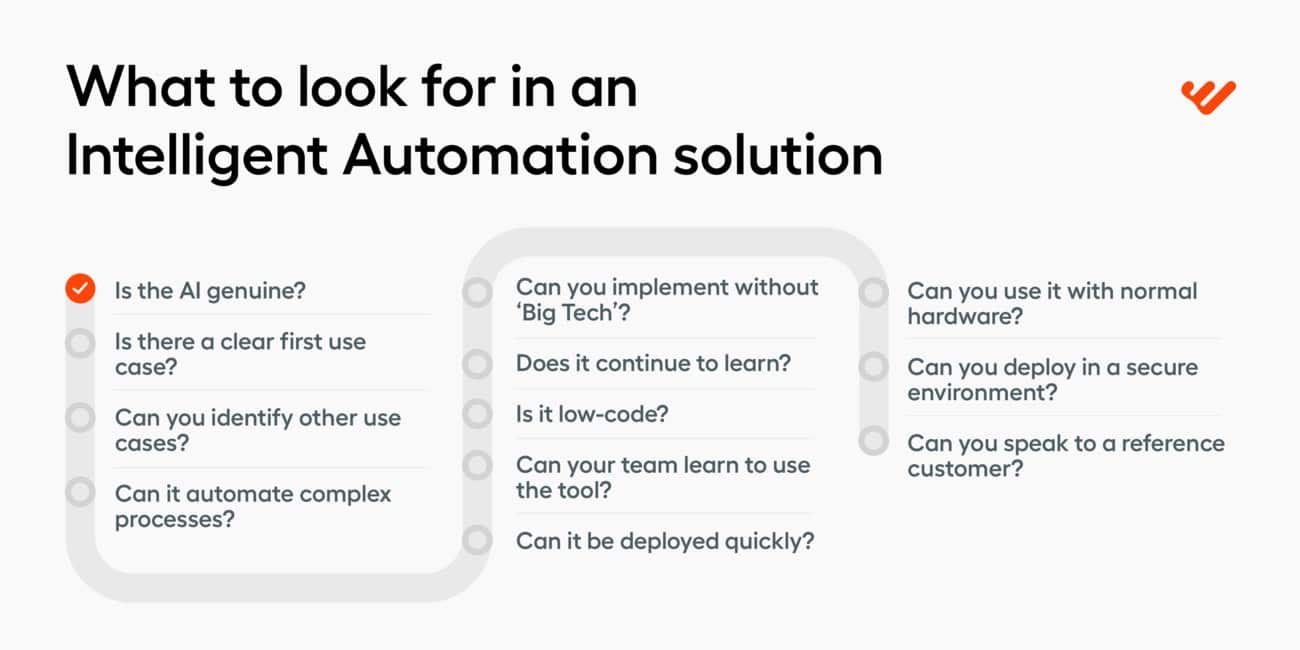You want to transform your business through automation. You hope to improve service, cut costs, and enhance compliance. You know you need to invest in an Intelligent Automation (IA) platform, powered by Artificial Intelligence (AI). Perhaps you’ve already had some success with Robotic Process Automation (RPA) or you’re at the start of your journey and looking for a future-proof solution. With unstructured data and complex processes, you know intelligence will be key.
Selecting an Intelligent Automation vendor is hard
There’s a huge amount of hype and noise. Many companies talk a good game, but a survey of 2,830 AI startups showed that 40 percent don’t use AI in a “material” way. Some startups compensate for their lack of product with a data science team, building custom solutions each time. Others lack AI altogether, relying on people in the background to give an appearance of intelligence.
How to start an AI startup
— Gregory Koberger (@gkoberger) March 1, 2016
1. Hire a bunch of minimum wage humans to pretend to be AI pretending to be human
2. Wait for AI to be invented
All the leading RPA vendors have offered an Intelligent Automation vision, accompanied by glossy presentations. Yet years later, most RPA software vendors just have a “python container,” meaning you need to build the AI yourself. Even if they have AI case studies, too often these are dependent upon “integration with third-party cognitive services.” Both approaches are costly, with multiple license fees, complex maintenance, and high technical debt. It begs the question: Why not go direct?
AI is a complex field, with its own terminology. Executives want to talk about business processes, problems, and solutions. Data scientists instead want to talk about feature engineering, hyperparameter optimization and model ensembles. This makes it difficult for business people to understand what they are buying in practical terms. At worst, jargon is used as a cover for “vaporware” that doesn’t exist yet.

Is the AI genuine?
Intelligent Automation is underpinned by AI. Choose a provider that genuinely offers its own capabilities, then evaluate these capabilities. If your solution is being packaged off-site, without clarity into development or maintenance, this is a red flag. “Integration with third-party cognitive services” is another red flag.
Is there a clear first use case?
To achieve a return on investment you need to solve a business problem. AI for the sake of AI is just a waste. Finding your first use case can be a hurdle. Choose a vendor who helps you identify and evaluate that first step. Even better, look for proven use cases and pre-built accelerators like pre-trained bots. Minimize your risk and maximize quick wins; prove the technology to your stakeholders.
Can you identify other use cases?
To achieve real transformation, finding one use case isn’t enough. Choose a provider whose capabilities would enable you to tackle multiple problems. You can achieve huge ROI via process automation of a few big complex tasks, or a wide range of smaller ones. Also, look for capabilities that help you quickly discover and implement new use cases.
Can it automate complex processes?
Traditional RPA tools offered by RPA vendors can automate simple, repetitive tasks, with structured data. Real-world business processes are much more difficult to manage. Choose a vendor who can work with complexity. Look for the ability to work with a wide range of inputs — regardless of source, language or format. You want to trust your automation solution to complete complex work, so you can automate whole roles — from categorizing incoming emails through to extracting data from documents, reconciling transactions and evaluating risk.
Can you implement without ‘Big Tech’?
The big tech companies like Microsoft, Google, Apple, and Amazon are leaders in AI, particularly for consumer applications. However, their main strength is on general applications (like translation, virtual assistants and photo enhancement). Their services often come packaged with their cloud-based offering and can compromise control of your data. There’s also a risk they use the experience to launch a competitive offering. Choose a vendor that can support you for your specific use case, without dependency upon Big Tech. Tailor the solution to your specific process and requirements (from customs documentation to insurance claims or banking settlement instructions). Don’t compromise on data privacy.
Can you implement on-premise?
With increasing regulation, tight data privacy laws across the developed world, and numerous data leaks, consider looking for a solution you can deploy on-premise. Even if you’ve successfully transitioned to off-site solutions in the past, choose a vendor who can implement on-premise or in your private cloud servers. This gives you maximum flexibility later on. It also validates that they have genuine AI capabilities, without tricks in the background. Learning robots should learn from your data.
Does it continue to learn?
Businesses are dynamic and change. Bots need to be updated. According to McKinsey, one in three AI use cases needs to be updated monthly, and one in four refreshed daily. Choose an automation solution vendor whose robots can continuously learn. When your business processes or data changes, you’ll want bots that adapt.
Is it low-code?
Data science skills are expensive and in short supply. There’s a shortage of around 150,000 people in the USA, according to Linkedin. Choose an automation solution that lets you implement quickly and maintain easily. Ideally, business analysts and subject matter experts can contribute too.
Can your team learn to use the tool?
In the short term, a robotic automation company or a consulting firm might help you start your Intelligent Automation journey. Longer-term, you’ll want to be in control. Choose a vendor whose automation solution is easy enough to learn, and who offers the associated training. This way, you can reduce implementation costs and scale up beyond the first few use cases.
Can it be deployed quickly?
Creating a learning bot and automating a process will only have value if used in the real world. Choose a vendor whose technology you can deploy quickly. Examine the time to value: How quickly will you get from process discovery through to implementation in production? Is it a matter of years, months or weeks? This becomes especially important when you seek to scale automation across the organization.
Can you use normal hardware?
A lot of AI development takes place on custom frameworks with custom hardware. Google, for example, has custom Tensor Processing Units (TPUs) with Application-Specific Integrated Circuits (ASICs). Many others use Graphical Processing Units (GPUs), originally designed for video gaming, but well-suited to AI applications. Choose a vendor who allows for the use of normal hardware. Using your own hardware will enable you to get started faster, at a lower cost.
Can you speak to a reference customer?
Before you buy, you should speak with another customer. This may give you key insight into achieving success, as well as validate that you’re making a good decision. Choose a vendor who can provide references. Use those references to assuage any doubts, identify any challenges, and better prepare for success.
Partnering with WorkFusion
WorkFusion is here to help. We want to solve your business problems. While yes, we have great technology (which is why Everest Group named us a leader in Intelligent Document Processing), our focus is on making sure you select the right automation solution for your use case, with short time to value and high ROI. Contact us to find out more or see a demonstration of how WorkFusion’s Intelligent Automation Cloud can work for you.
Also published on Medium.































